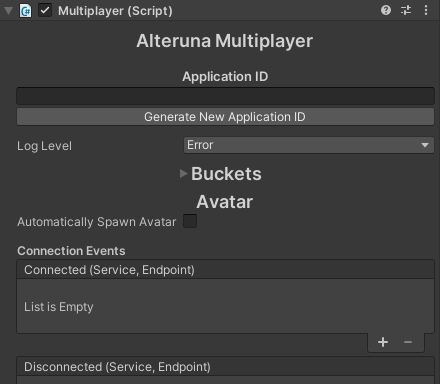02 Multiplayer Component - Alteruna/au-multiplayer-guide GitHub Wiki
The multiplayer component is what enables a Unity project to become a multiplayer application. In order for your application to work with Alteruna Multiplayer, there must be a Multiplayer Component in the scene.
The component looks like this:

Figure 2.1
In order for applications to discover and exchange application state with other running instances on the network, each application must be assigned a unique Global Unique Identifier (GUID). This is what we refer to as the Application ID. The application ID acts as a filter and allows your application to solely discover and connect to other instances of the same application.
You can Generate a new Application ID by pressing the Generate Application ID button.
You can choose to decide the severity log level of output from Alteruna Multiplayer. The log level defines the least level of output you wish to get from the framework and acts as a log message filter. Anything with the chosen severity grade and below will pass through the filter and get logged in Unity’s console. During development, common practice is to keep the log level at Debug. This will effectively force Alteruna Multiplayer to log all messages to Unity’s console. During deployment, a severity grade of Error or None is recommended for performance.
- A bucket is a list of Users in the Room.
- A User can only be in one bucket at a time.
- Network traffic can be regulated separately to separate Buckets by sending data to different people at different rates.
This display shows the current state of all the buckets in the project.

Figure 2.2
This menu can be used to automatically spawn Avatars to represent each User in a Room.
If you enable Automatically Spawn Avatar the menu will give you more options like this.

Figure 2.3